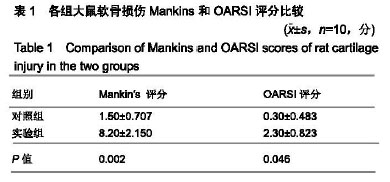| [1]Bastick AN ,Belo JN ,Runhaar J ,et al.What are the prognostic factors for imaging progress of knee osteoarthritis .Clin Orthop Relat Res.2015; 473:2969-2989.[2]Chen N, Wang J, Mucelli A,et al. Electroacupuncture is beneficial for knee osteoarthritis: the evidence from meta-analysis of randomized controlled trials.Am J Chin Med. 2017;45:965-985. [3]吴清洪,杨朝湘,邹华章,等.猪膝关节早期骨性关节炎模型的建立[J].动物医学进展,2018,39(6):33-37.[4]Mankin HJ,Dorfman H,Lippillo L,et al.Biochemical and metabolic abnormalities in articular cartilage from osteo-arthritic human hips. J Bone joint Surg(Am).1971; 53(3):523-537.[5]Pritzker KP, Gay S, Jimenez SA, et al.Osteoarthritis cartilage histopathology: grading and staging.Osteoarthritis Cartilage. 2006;14(10):13-29. [6]Rutgers M, van Pelt MJP, Dhert WJA,et al.Evaluation of histological scoring systems for tissue-engineered, repaired and osteoarthritic cartilage. Osteoarthritis Cartilage.2010; 18(1):12–23.[7]Aigner T, Cook JL, Gerwin N, et al. Histopathology atlas of animal model systems—overview of guiding principles. Osteoarthritis Cartilage. 2010;18, Supplement 3:S2-6.[8]苏睿. 膝关节骨性关节炎治疗进展研究[J].中医临床研究,2016, 8(2): 145-146. [9]Karsdal MA,Christiansen C,Ladel C,et al.Osteoarthritis-a case for personalized health care? Osteoarthritis Cartilage. 2014;22(1):7-16.[10]Matthews GL.Disease modification: promising targets and impediments to success. Rheum Dis Clin N Am. 2013;39(1): 177-187.[11]许蓓,许进.骨关节炎发病机制及治疗进展[J].浙江医学,2017, 39(21) :1833-1835. [12]尹宏,俞宁,钱卫庆.奇正消痛贴治疗膝骨性关节炎临床疗效观察[J].白求恩军医学院学报,2010,12(6):8. [13]中华医学会骨科学分会关节外科学组.骨关节炎诊疗指南 (2018年版) [J].中华骨科杂志, 2018, 38(12):705-715.[14]Lampropoulou-Adamidou K, Lelovas P, Karadimas EV, et al. Useful animal models for the research of osteoarthritis. Eur J Orthop Surg Traumatol.2014;24(3):263-271.[15]Bendele AM. Animal models of osteoarthritis.J Musculoskelet Neuronal Interact.2001;1(4):363-376.[16]Poole R, Blake S, Buschmann M, et al. Recommendations for the use of preclinical models in the study and treatment of osteoarthritis. Osteoarthritis Cartilage. 2010;18, Supplement 3:S10-16.[17]McCoy AM. Animal models of osteoarthritis: comparisons and key considerations. Vet Pathol. 2015;52(5):803-818.[18]Jimenez PA, Glasson SS, Trubetskoy OV, et al. Spontaneous osteoarthritis in Dunkin Hartley guinea pigs: histologic, radiologic, and biochemical changes. Lab Anim Sci.1997; 47(6):598-601.[19]Glyn-Jones S, Palmer AJR, Agricola R,et al.Osteoarthritis. Lancet.2015;386(9991):376-387.[20]Havdrup T, Henricson A, Telhag H. Papain-induced mitosis of chondrocytes in adult joint cartilage: an experimental study in full-grown rabbits. Acta Orthop Scand.1982;53:119-124. [21]Pritzker KP. Animal models for osteoarthritis: processes, problems and prospects. Ann Rheum Dis. 1994;53(6): 406-420.[22]Kikuchi T, Sakuta T, Yamaguchi T. Intra-articular injection of collagenase induces experimental osteoarthritis in mature rabbits. Osteoarthr Cartil.1998;6:177-186.[23]Khan HM, Ashraf M, Hashmi AS, et al. Papain induced progressive degenerative changes in articular cartilage of rat femorotibial joint and its histopathological grading. J Anim Plant Sci. 2013;23(2):350-358.[24]Braun HJ,Gold GE.Diagnosis of osteoarthritis: imaging. Bone. 2012;51(2):278-288.[25]Kraus VB, Blanco FJ, Englund M, et al. Call for standardized definitions of osteoarthritis and risk stratification for clinical trials and clinical use. Osteoarthritis Cartilage. 2015;23(8): 1233-1241.[26]Ferrazzo KL, Osório LB, Ferrazzo VA. CT images of a severe TMJ osteoarthritis and differential diagnosis with other joint disorders. Case Rep Dentistry. 2013;2013:5.[27]Piscaer TM,Waarsing JH,Kops N,et al.In vivo imaging of cartilage degeneration using μCT-arthrography. Osteoarthritis Cartilage.2008;16(9): 1011-1017.[28]谢希,高洁生.骨关节炎动物模型研究进展[J].医学综述,2005, 11(1):67-69.[29]Park J,Lee J,Kim KI,A Pathophysiological Validation of Collagenase II-Induced Biochemical Osteoarthritis Animal Model in Rabbit.Tissue Eng Regen Med.2018;15(4):437-444.[30]Kuyinu EL,Narayanan G,Nair LS,et al. Animal models of osteoarthritis: classification, update, and measurement of outcomes. J Orthop Surg Res. 2016;11:19.[31]Murakami K, Nakagawa H, Nishimura K,et al. Changes in peptidergic fiber density in the synovium of mice with collagenase-induced acute arthritis. Can J Physiol Pharmacol. 2015;93(6):435-441.[32]Kumagai K, Suzuki S,Kanri Y,et al.Spontaneously developed osteoarthritis in the temporomandibular joint in STR/ort mice. Biomed Rep.2015;3(4):453-456. [33]Staines KA,Poulet B,Wentworth DN,et al. The STR/ort mouse model of spontaneous osteoarthritis—an update. Osteoarthritis Cartilage.2017;25(6):802-808.[34]Motomura H,Seki S,Shiozawa S,et al. A selective c-Fos/AP-1 inhibitor prevents cartilage destruction and subsequent osteophyte formation. Biochem Biophys Res Commun.2018; 497(2):756-761.[35]Morse A,McDonald MM,Kelly NH,et al.Mechanical load increases in bone formation via a sclerostin-independent pathway.J Bone Miner Res.2014;29 (11):2456-2467.[36]Christiansen BA,Guilak F,Lockwood KA,et al.Non-invasive mouse models of post-traumatic osteoarthritis. Osteoarthritis Cartilage. 2015;23(10):1627-1638. |
.jpg) 文题释义:
非侵入性方法诱导动物模型:是一种采用机械压头提供的冲击力导致关节内闭合性骨折。其优势在于:①由机械驱动,通过机械冲击造成伤害,无需任何化学或外科手术干预,因而不会导致动物皮肤破裂;②可以精确地创建损伤,这在传统方法中是不可行的;③结果具有高度可重复性;④可以给予每只动物的结果精确度;⑤能够去除任何手术干预的伪影,例如研究者的熟练程度和炎症变化或手术本身引起的因素;⑥密切模拟导致创伤后骨关节炎的人体损伤。
木瓜蛋白酶:是一种蛋白水解酶。木瓜蛋白酶产生早期的膝关节骨性关节炎模型的机制是通过影响细胞外基质中的蛋白多糖而损害胶原蛋白的整合。木瓜蛋白酶与其他化学诱导试剂相比优势在于对胶原蛋白和软骨细胞没有直接影响。
文题释义:
非侵入性方法诱导动物模型:是一种采用机械压头提供的冲击力导致关节内闭合性骨折。其优势在于:①由机械驱动,通过机械冲击造成伤害,无需任何化学或外科手术干预,因而不会导致动物皮肤破裂;②可以精确地创建损伤,这在传统方法中是不可行的;③结果具有高度可重复性;④可以给予每只动物的结果精确度;⑤能够去除任何手术干预的伪影,例如研究者的熟练程度和炎症变化或手术本身引起的因素;⑥密切模拟导致创伤后骨关节炎的人体损伤。
木瓜蛋白酶:是一种蛋白水解酶。木瓜蛋白酶产生早期的膝关节骨性关节炎模型的机制是通过影响细胞外基质中的蛋白多糖而损害胶原蛋白的整合。木瓜蛋白酶与其他化学诱导试剂相比优势在于对胶原蛋白和软骨细胞没有直接影响。.jpg) 文题释义:
非侵入性方法诱导动物模型:是一种采用机械压头提供的冲击力导致关节内闭合性骨折。其优势在于:①由机械驱动,通过机械冲击造成伤害,无需任何化学或外科手术干预,因而不会导致动物皮肤破裂;②可以精确地创建损伤,这在传统方法中是不可行的;③结果具有高度可重复性;④可以给予每只动物的结果精确度;⑤能够去除任何手术干预的伪影,例如研究者的熟练程度和炎症变化或手术本身引起的因素;⑥密切模拟导致创伤后骨关节炎的人体损伤。
木瓜蛋白酶:是一种蛋白水解酶。木瓜蛋白酶产生早期的膝关节骨性关节炎模型的机制是通过影响细胞外基质中的蛋白多糖而损害胶原蛋白的整合。木瓜蛋白酶与其他化学诱导试剂相比优势在于对胶原蛋白和软骨细胞没有直接影响。
文题释义:
非侵入性方法诱导动物模型:是一种采用机械压头提供的冲击力导致关节内闭合性骨折。其优势在于:①由机械驱动,通过机械冲击造成伤害,无需任何化学或外科手术干预,因而不会导致动物皮肤破裂;②可以精确地创建损伤,这在传统方法中是不可行的;③结果具有高度可重复性;④可以给予每只动物的结果精确度;⑤能够去除任何手术干预的伪影,例如研究者的熟练程度和炎症变化或手术本身引起的因素;⑥密切模拟导致创伤后骨关节炎的人体损伤。
木瓜蛋白酶:是一种蛋白水解酶。木瓜蛋白酶产生早期的膝关节骨性关节炎模型的机制是通过影响细胞外基质中的蛋白多糖而损害胶原蛋白的整合。木瓜蛋白酶与其他化学诱导试剂相比优势在于对胶原蛋白和软骨细胞没有直接影响。

.jpg)
.jpg) 文题释义:
非侵入性方法诱导动物模型:是一种采用机械压头提供的冲击力导致关节内闭合性骨折。其优势在于:①由机械驱动,通过机械冲击造成伤害,无需任何化学或外科手术干预,因而不会导致动物皮肤破裂;②可以精确地创建损伤,这在传统方法中是不可行的;③结果具有高度可重复性;④可以给予每只动物的结果精确度;⑤能够去除任何手术干预的伪影,例如研究者的熟练程度和炎症变化或手术本身引起的因素;⑥密切模拟导致创伤后骨关节炎的人体损伤。
木瓜蛋白酶:是一种蛋白水解酶。木瓜蛋白酶产生早期的膝关节骨性关节炎模型的机制是通过影响细胞外基质中的蛋白多糖而损害胶原蛋白的整合。木瓜蛋白酶与其他化学诱导试剂相比优势在于对胶原蛋白和软骨细胞没有直接影响。
文题释义:
非侵入性方法诱导动物模型:是一种采用机械压头提供的冲击力导致关节内闭合性骨折。其优势在于:①由机械驱动,通过机械冲击造成伤害,无需任何化学或外科手术干预,因而不会导致动物皮肤破裂;②可以精确地创建损伤,这在传统方法中是不可行的;③结果具有高度可重复性;④可以给予每只动物的结果精确度;⑤能够去除任何手术干预的伪影,例如研究者的熟练程度和炎症变化或手术本身引起的因素;⑥密切模拟导致创伤后骨关节炎的人体损伤。
木瓜蛋白酶:是一种蛋白水解酶。木瓜蛋白酶产生早期的膝关节骨性关节炎模型的机制是通过影响细胞外基质中的蛋白多糖而损害胶原蛋白的整合。木瓜蛋白酶与其他化学诱导试剂相比优势在于对胶原蛋白和软骨细胞没有直接影响。